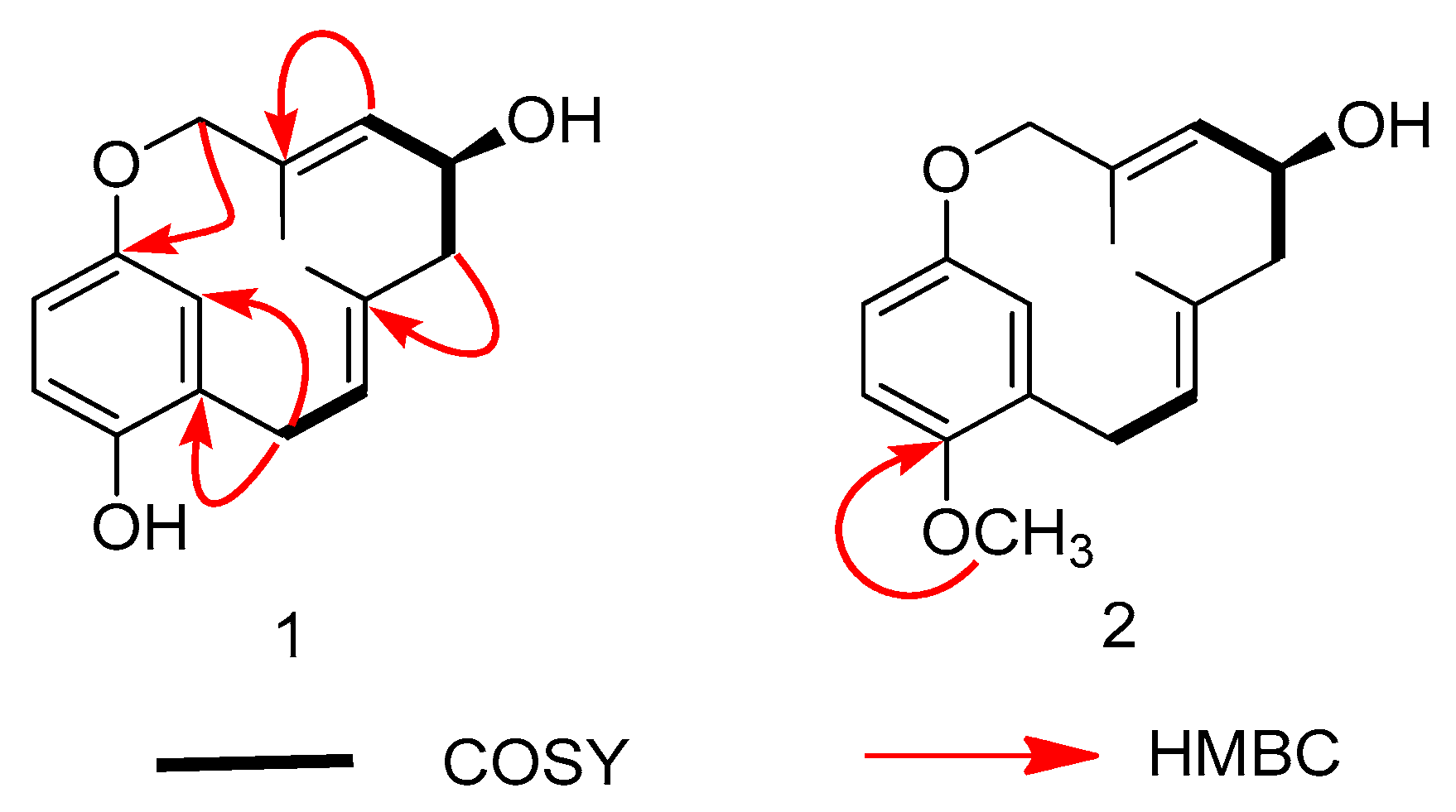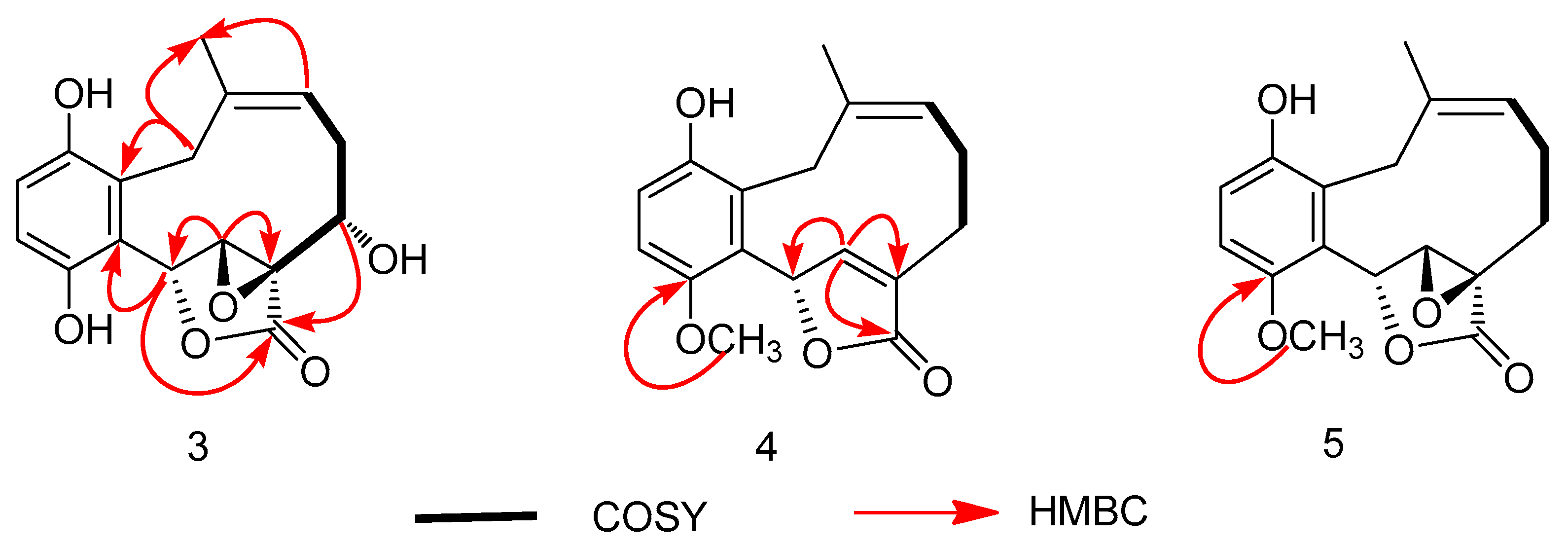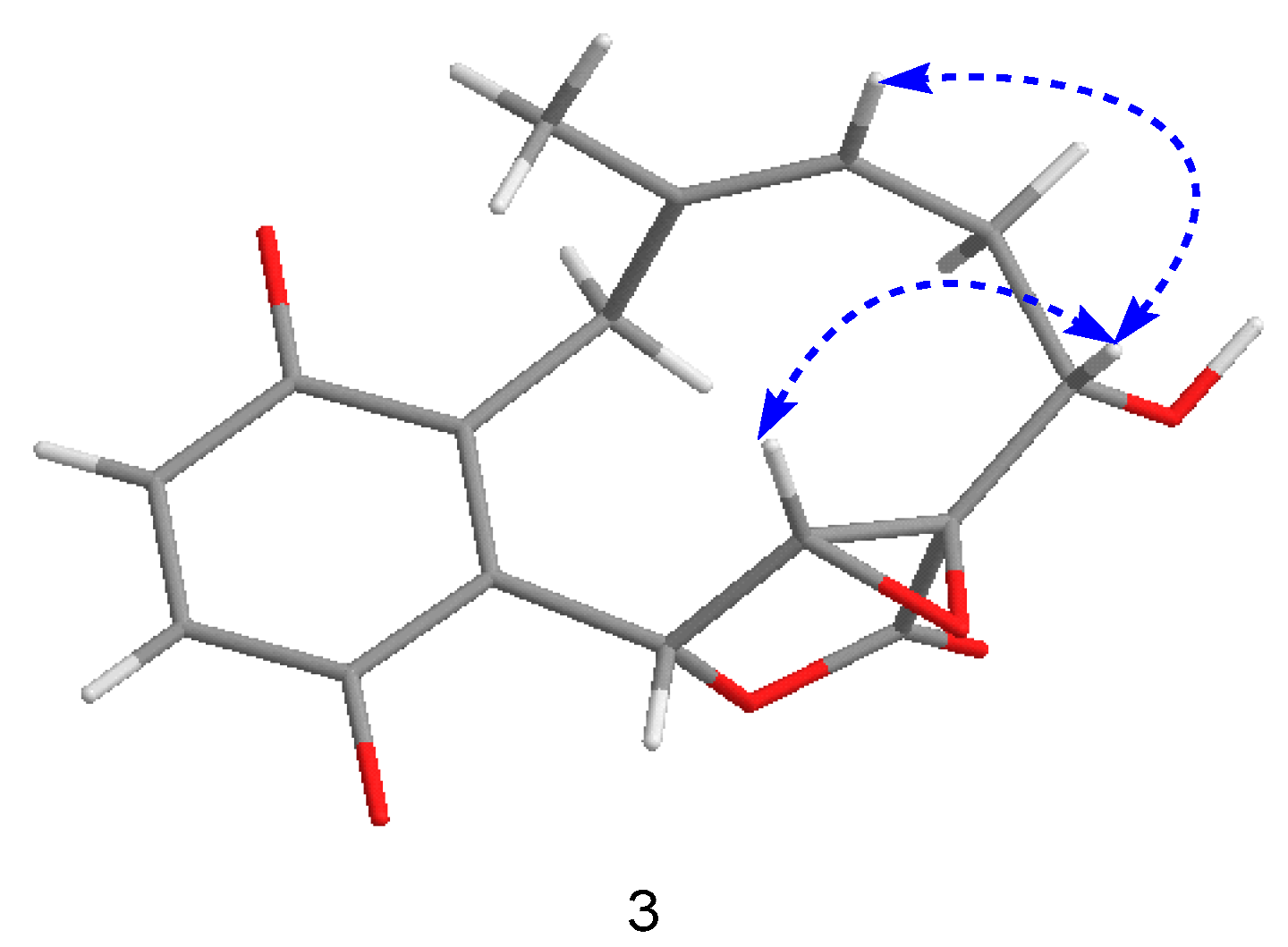Five New Meroterpenoids from the Fruiting Bodies of the Basidiomycete Clitocybe clavipes with Cytotoxic Activity
Abstract
1. Introduction
2. Results
Spectra Data were Recorded in CDCl3
3. Discussion
4. Materials and Methods
4.1. General Experimental Procedures
4.2. Computational Methods
4.3. Fungal Material
4.4. Extraction and Isolation
4.5. Cytotoxicity Assays
Supplementary Materials
Author Contributions
Funding
Conflicts of Interest
Abbreviations
| IR | Infrared |
| NMR | Nuclear magnetic resonance |
| HR-ESI-MS | High resolution electrospray ionization mass spectroscopy |
| HMBC | Heteronuclear multiple bond correlation |
| HSQC | Heteronuclear single quantum correlation |
| COSY | Homonuclear chemical shift Correlation Spectroscopy |
| NOESY | Nuclear overhauser effect spectroscopy |
| ROESY | Rotating frame overhauser effect spectroscopy |
| APFD | Austin-Frisch-Petersson functional with dispersion |
| TMS | Tetramethylsilane |
| ODS | Octadecyl silane |
| HPLC | High performance liquid chromatography |
| CH2Cl2 | Dichloromethane |
| EtOAc | Ethyl acetate |
| MeOH | Methanol |
| MTT | 3-(4,5-Dimethylthiazol-2-yl)-2,5-diphenyltetrazolium bromide |
References
- Niu, Z.; Chen, Y.; Guo, H.; Li, S.N.; Li, H.H.; Liu, H.X.; Liu, Z.; Zhang, W. Cytotoxic Polyketides from a Deep-Sea Sediment Derived Fungus Diaporthe phaseolorum FS431. Molecules 2019, 24, 3062. [Google Scholar] [CrossRef] [PubMed]
- Verma, V.C.; Kharwar, R.N.; Strobel, G.A. Chemical and functional diversity of natural products from plant associated endophytic fungi. Nat. Prod. Commun. 2009, 4, 1511–1532. [Google Scholar] [CrossRef] [PubMed]
- Tang, Y.; Xue, Y.; Du, G.; Wang, J.; Liu, J.; Sun, B.; Li, X.N.; Yao, G.; Luo, Z.; Zhang, Y. Structural revisions of a class of natural products: Scaffolds of aglycon analogues of fusicoccins and cotylenins isolated from fungi. Angew. Chem. Int. Ed. 2016, 128, 4137–4141. [Google Scholar] [CrossRef]
- Geris, R.; Simpson, T.J. Meroterpenoids produced by fungi. Nat. Prod. Rep. 2009, 26, 1063. [Google Scholar] [CrossRef] [PubMed]
- Tomoda, H.; Nishida, H.; Kim, Y.K.; Obata, R.; Sunazuka, T.; Omura, S. Relative and absolute stereochemistry of pyripyropene A, a potent, bioavailable inhibitor of Acyl-CoA:Cholesterol Acyltransferase (ACAT). J. Am. Chem. Soc. 1994, 116, 12097–12098. [Google Scholar] [CrossRef]
- Kuno, F.; Shiomi, K.; Otoguro, K.; Sunazuka, T.; Omura, S. Arisugacins A and B, novel and selective acetylcholinesterase inhibitors from penicillium sp. F0-4259. II. structure elucidation. J. Antibiot. 1996, 49, 748–751. [Google Scholar] [CrossRef] [PubMed][Green Version]
- He, Y.; Zheng, M.; Li, Q.; Hu, Z.; Zhu, H.; Liu, J.; Wang, J.; Xue, Y.; Li, H.; Zhang, Y. Asperspiropene A, a novel fungal metabolite as an inhibitor of cancer-associated mutant isocitrate dehydrogenase 1. Org. Chem. Front. 2017. [Google Scholar] [CrossRef]
- Liu, Z.; Liu, H.; Chen, Y.; She, Z. A new anti-inflammatory meroterpenoid from the fungus Aspergillus terreus H010. Nat. Prod. Res. 2017, 32, 1–5. [Google Scholar] [CrossRef] [PubMed]
- Peng, X.; Li, L.; Wang, X.; Zhu, G.; Li, Z.; Qiu, M. Antioxidant farnesylated hydroquinones from Ganoderma capense. Fitoterapia 2016, 111, 18–23. [Google Scholar] [CrossRef] [PubMed]
- Xu, L.; Meng, W.; Cao, C.; Wang, J.; Shan, W.; Wang, Q. Antibacterial and antifungal compounds from marine fungi. Mari. Drugs 2015, 13, 3479–3513. [Google Scholar] [CrossRef] [PubMed]
- Larrosa, I.; Da Silva, M.I.; Gómez, P.M.; Hannen, P.; Ko, E.; Lenger, S.R.; White, A.J.P.; Wilton, D.; Barrett, A.G.M. Highly convergent three component benzyne coupling: The total synthesis of ent-clavilactone B. J. Am. Chem. Soc. 2006, 128, 14042–14043. [Google Scholar] [CrossRef] [PubMed]
- Takao, K.; Mori, K.; Kasuga, K.; Nanamiya, R.; Namba, A.; Fukushima, Y.; Nemoto, R.; Mogi, T.; Yasui, H.; Ogura, A.; et al. Total Synthesis of Clavilactones. J. Org. Chem. 2018, 83, 7060–7075. [Google Scholar] [CrossRef] [PubMed]
- Arnone, A.; Cardillo, R.; Meille, S.V.; Nasini, G.; Tolazz, M. Secondary mould metabolites. Part 47. isolation and structure elucidation of clavilactones A-C, new metabolites from the fungus Clitocybe clavipes. J. Chem. Soc. Perkin Trans. 1 1994, 2165–2168. [Google Scholar] [CrossRef]
- Merlini, L.; Nasini, G.; Scaglioni, L.; Cassinelli, G.; Lanzi, C. Structure elucidation of clavilactone D: An inhibitor of protein tyrosine kinases. Phytochemistry 2000, 53, 1039–1041. [Google Scholar] [CrossRef]
- Kawagishi, H.; Miyazawa, T.; Kume, H.; Arimoto, Y.; Inakuma, T. Aldehyde dehydrogenase inhibitors from the mushroom Clitocybe clavipes. J. Nat. Prod. 2002, 65, 1712–1714. [Google Scholar] [CrossRef] [PubMed]
- Cassinelli, G.; Lanzi, C.; Pensa, T.; Gambetta, R.A.; Nasini, G.; Cuccuru, G.; Cassinis, M.; Pratesi, G.; Polizzi, D.; Tortoreto, M.; et al. Clavilactones, a novel class of tyrosine kinase inhibitors of fungal origin. Biochem. Pharmacol. 2000, 59, 1539–1547. [Google Scholar] [CrossRef]
- Sun, Z.; Zhu, N.; Zhou, M.; Huo, X.; Wu, H.; Tian, Y.; Yang, J.; Ma, G.; Yang, Y.L.; Xu, X. Clavipines A–C, antiproliferative meroterpenoids with a fused azepine skeleton from the basidiomycete Clitocybe clavipes. Org. Chem. Front. 2019. [Google Scholar] [CrossRef]
- Yao, X.S.; Ebizuka, Y.; Noguchi, H.; Kiuchi, F.; Shibuya, M.; Iitaka, Y.; Seto, H.; Ushio, S. Biologically active constituents of arnebia euchroma: Structure of arnebinol, an ansa-type monoterpenylbenzenoid with inhibitory activity on prostaglandin biosynthesis. Chem. Pharm. Bull. 1991, 39, 2956–2961. [Google Scholar] [CrossRef] [PubMed]
- Chen, J.J.; Hung, H.C.; Sung, P.J.; Chen, I.S.; Kuo, W.L. Aporphine alkaloids and cytotoxic lignans from the roots of Illigera luzonensis. Phytochemistry 2011, 72, 523–532. [Google Scholar] [CrossRef] [PubMed]
- Yin, X.; Feng, T.; Li, Z.H.; Dong, Z.J.; Li, Y.; Liu, J. Highly oxygenated meroterpenoids from fruiting bodies of the mushroom Tricholoma terreum. J. Nat. Prod. 2013, 76, 1365–1368. [Google Scholar] [CrossRef] [PubMed]
Sample Availability: Samples of the compounds (1–5) are not available from the authors. |






| 1 | 2 | |||
|---|---|---|---|---|
| No. | δH, (J in Hz) | δC | δH, (J in Hz) | δC |
| 1 | - | 151.6 | - | 151.6 |
| 2 | 6.56, dd (3.0, 8.4) | 115.3 | 6.64, dd (3.0, 8.4) | 114.7 |
| 3 | 6.60,d (8.4) | 115.8 | 6.69, d (8.4) | 111.3 |
| 4 | - | 147.1 | - | 151.4 |
| 5 | - | 127.4 | - | 129.9 |
| 6 | 3.04, dd (8.4, 16.8),b 3.34, dd (7.2, 16.8),a | 25.7 | 3.03, dd (8.4, 16.8),b 3.39, dd (7.2, 16.8),a | 25.9 |
| 7 | 5.74, t (7.2) | 126.6 | 5.73, t (7.2) | 127.2 |
| 8 | - | 135.7 | - | 135.3 |
| 9 | 2.36, t (12),b 2.71, dd (4.2, 12),a | 48.6 | 2.35, t (12),b 2.71, dd (4.2, 11.4),a | 48.7 |
| 10 | 4.68, m | 66.0 | 4.68, m | 66.0 |
| 11 | 5.56, d (10.2) | 135.4 | 5.57, d (10.2) | 135.3 |
| 12 | - | 136.5 | - | 136.6 |
| 13 | 4.46, d (12.6), b 4.64, d (12.6), a | 76.2 | 4.47, d (12.6), b 4.66, d (12.6), a | 76.2 |
| 14 | 7.23, d (3.0) | 117.8 | 7.30, d (3.0) | 118.0 |
| 15 | 1.56, s | 13.4 | 1.56, s | 13.4 |
| 16 | 1.24, s | 16.1 | 1.23, s | 16.1 |
| -OCH3 | - | - | 3.78, s | 56.1 |
| 3 a | 4 b | 5 b | ||||
|---|---|---|---|---|---|---|
| No. | δH, (J in Hz) | δC | δH, (J in Hz) | δC | δH, (J in Hz) | δC |
| 1 | - | 151.0 | - | 149.1 | - | 148.9 |
| 2 | 6.77, d (8.4) | 118.9 | 6.79, d (8.4) | 117.2 | 6.83, d (9.0) | 117.5 |
| 3 | 6.66, d (8.4) | 115.7 | 6.75, d (8.4) | 111.1 | 6.75, d (9.0) | 110.8 |
| 4 | - | 151.0 | - | 153.1 | - | 153.1 |
| 5 | - | 120.8 | - | 120.5 | - | 122.4 |
| 6 | 6.30, s | 77.1 | 6.84, s | 76.1 | 6.37, s | 74.6 |
| 7 | 4.02, s | 64.7 | 6.80, s | 149.7 | 4.01, s | 63.8 |
| 8 | - | 62.8 | - | 129.2 | - | 61.8 |
| 9 | 3.47,dd (3.0,12.0), m | 71.3 | 1.87, m, b 2.74, m, a | 25.6 | 1.27, m, b 2.73, m, a | 25.3 |
| 10 | 2.27, m, b 2.85, m, a | 33.4 | 1.97, m, b 2.23, m, a | 24.9 | 2.18, m, b 2.48, m, a | 22.7 |
| 11 | 5.27, t (7.8) | 119.8 | 5.12, t (7.8) | 121.4 | 5.27, t (8.4) | 122.4 |
| 12 | - | 141.7 | - | 140.1 | - | 137.8 |
| 13 | 3.02, d (15.6), b 3.69,d (15.6), a | 28.5 | 2.58, d (15.0), b 3.32, d (15.0), a | 27.0 | 3.09, d (15.6), b 3.693,d (15.6), a | 27.9 |
| 14 | - | 128.1 | - | 128.0 | - | 128.4 |
| 15 | 1.56, s | 22.1 | 1.59, s | 22.1 | 1.56, s | 21.6 |
| 16 | - | 172.8 | - | 175.2 | - | 172.8 |
| -OCH3 | - | - | 3.83, s | 57.1 | 3.80, s | 56.8 |
| Compounds | IC50 (μM) | ||
|---|---|---|---|
| Hela | SGC-7901 | SHG-44 | |
| 1 | 63.2 ± 0.43 a | 44.1± 0.5 | >100 |
| 2 | 38.6 ± 1.3 | 51.2 ± 0.7 | >100 |
| 3 | >100 | 62.2 ± 0.4 | >100 |
| 4 | 23.5 ± 0.4 | 14.5 ± 1.2 | 53.9 ± 2.4 |
| 5 | >100 | 84.2 ± 3.1 | >100 |
| Cisplatin | 2.7 ± 0.04 | 1.1 ± 0.05 | 1.8 ± 0.03 |
© 2019 by the authors. Licensee MDPI, Basel, Switzerland. This article is an open access article distributed under the terms and conditions of the Creative Commons Attribution (CC BY) license (http://creativecommons.org/licenses/by/4.0/).
Share and Cite
Sun, Z.; Xu, X.; Liang, H.; Xia, X.; Ma, G.; Shi, L. Five New Meroterpenoids from the Fruiting Bodies of the Basidiomycete Clitocybe clavipes with Cytotoxic Activity. Molecules 2019, 24, 4015. https://doi.org/10.3390/molecules24224015
Sun Z, Xu X, Liang H, Xia X, Ma G, Shi L. Five New Meroterpenoids from the Fruiting Bodies of the Basidiomycete Clitocybe clavipes with Cytotoxic Activity. Molecules. 2019; 24(22):4015. https://doi.org/10.3390/molecules24224015
Chicago/Turabian StyleSun, Zhaocui, Xudong Xu, Hanqiao Liang, Xinyi Xia, Guoxu Ma, and Leiling Shi. 2019. "Five New Meroterpenoids from the Fruiting Bodies of the Basidiomycete Clitocybe clavipes with Cytotoxic Activity" Molecules 24, no. 22: 4015. https://doi.org/10.3390/molecules24224015
APA StyleSun, Z., Xu, X., Liang, H., Xia, X., Ma, G., & Shi, L. (2019). Five New Meroterpenoids from the Fruiting Bodies of the Basidiomycete Clitocybe clavipes with Cytotoxic Activity. Molecules, 24(22), 4015. https://doi.org/10.3390/molecules24224015





